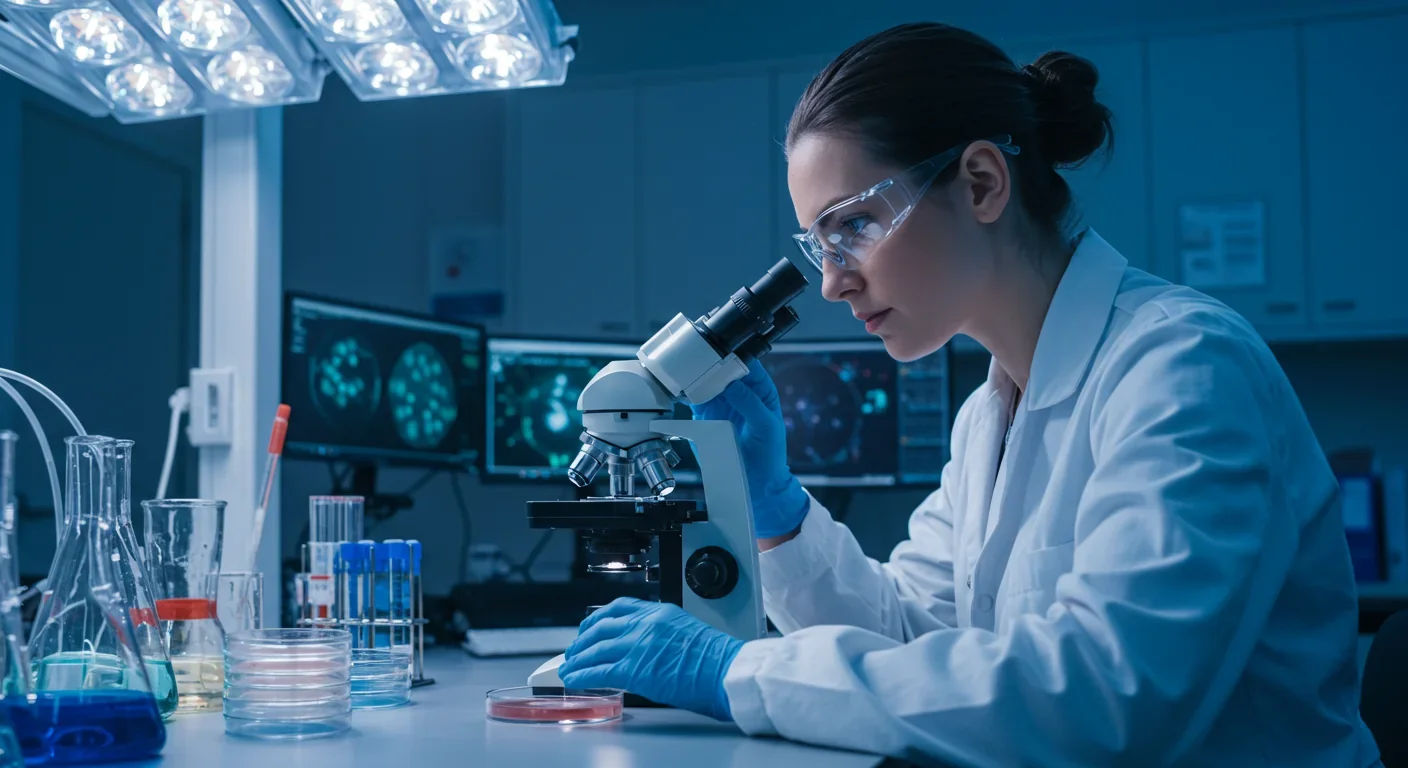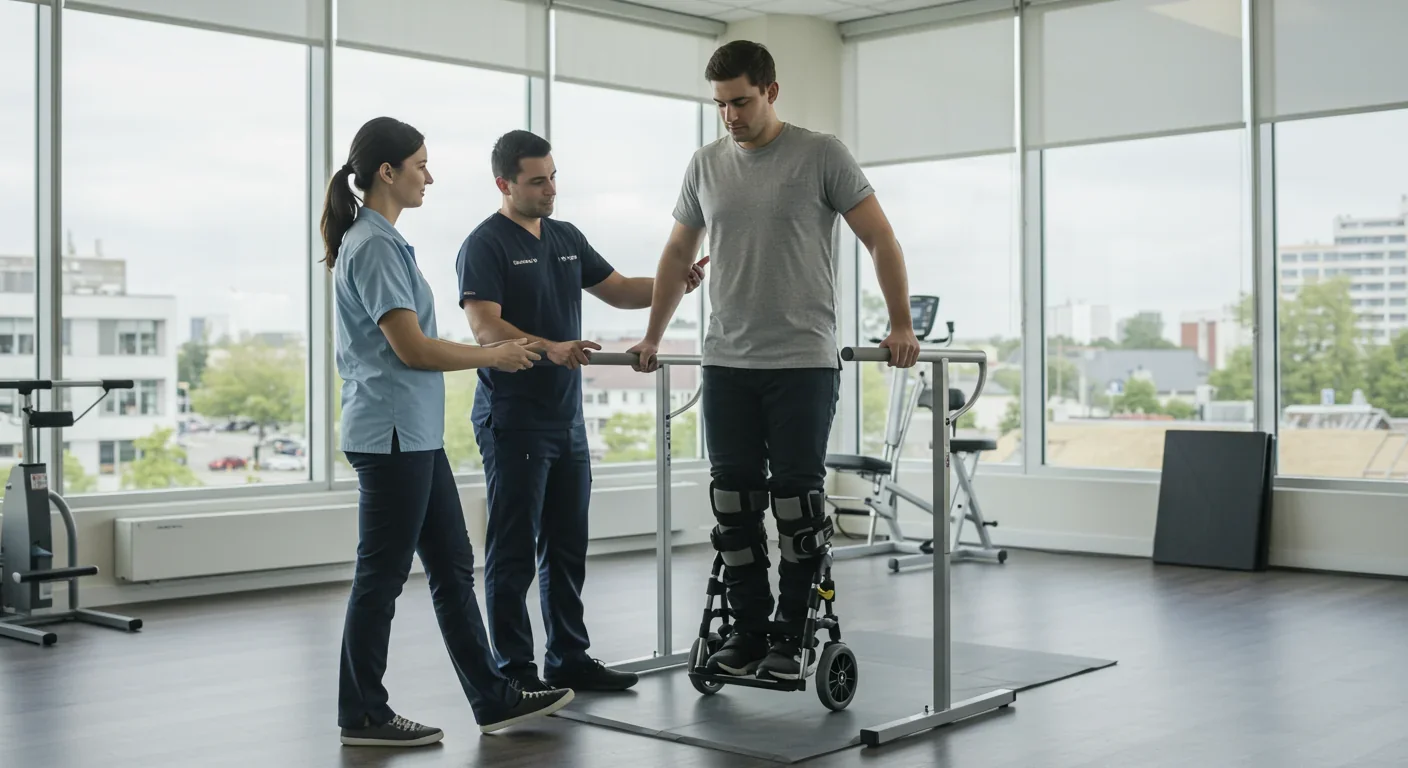Epigenetic Clocks Predict Disease 30 Years Early

TL;DR: Stem cell therapies are moving from laboratory promise to clinical reality, with patients walking after paralysis and damaged organs regenerating. Yet regulatory caution, manufacturing challenges, and inconsistent results mean the revolution will arrive gradually, transforming not just medicine but how humanity thinks about aging and human limitation.

In a Japanese hospital ward last September, a patient with spinal cord injuries walked for the first time since their accident. Not through years of physical therapy alone, but because stem cells injected into their damaged spinal cord had begun rebuilding neural connections that conventional medicine considers irreversibly lost. Meanwhile, in labs across three continents, hearts damaged by infarction are pumping stronger, livers are regenerating from cirrhosis, and kidneys are filtering toxins after receiving infusions of carefully cultured cells. We're witnessing something unprecedented: the human body learning to rebuild itself with a little biological coaching.
Stem cells repair damage through three main pathways, each more remarkable than pharmaceutical intervention alone. First, they directly replace lost cells by differentiating into specialized tissue matching their environment. When mesenchymal stem cells enter damaged heart muscle, some transform into cardiomyocytes, literally becoming beating heart cells. Second, they secrete a cocktail of growth factors—VEGF, PDGF, IGF—that stimulate existing cells to divide and repair. This paracrine effect often matters more than the cells themselves. Third, they modulate inflammation, calming the immune system's destructive overreaction that often causes more damage than the original injury.
The 2008 trachea transplant case exemplifies this beautifully. Surgeons took a donated windpipe, stripped it to its collagen scaffold, then recolonized it with the patient's own bone marrow stem cells. Because the cells came from her body, her immune system recognized them as self, eliminating the need for lifelong immunosuppression. The transplant succeeded where conventional surgery would have required permanent anti-rejection drugs with their cancer risks and infections.
But here's the catch: stem cells can't work alone. They depend on "niches"—specialized microenvironments that feed them survival signals and differentiation cues. Transplanted cells often die because they land in hostile territory without the biochemical support network they evolved to require. This explains why early trials showed modest results despite sound theory. We were sending soldiers into battle without supply lines.
The real breakthrough came from induced pluripotent stem cells (iPSCs), Shinya Yamanaka's 2006 discovery that won him the Nobel Prize. By introducing four genes into adult skin cells, he could rewind them to an embryonic-like state capable of becoming any cell type. Suddenly we could generate patient-specific stem cells without embryos, sidestepping the most contentious ethical debate while gaining immune-compatible cells.
The leap from laboratory promise to clinical reality happened faster in some organs than others. Bone marrow transplants have saved leukemia patients for decades, but that's relatively simple—blood stem cells naturally circulate and find their way home. Solid organs proved harder.
Cardiac regeneration saw major progress recently. A phase I/II trial of mesenchymal stem cells for ischemic cardiomyopathy showed 70% of patients improved their functional class, with ejection fraction increasing an average 5.9% at six months. That might sound modest, but for heart failure patients, a 6% improvement in pumping efficiency can mean the difference between climbing stairs normally versus breathlessness after three steps. Preclinical models showed even better results—10-15% ejection fraction gains in mice four weeks post-treatment.
Stroke recovery is emerging as another frontier. A September 2024 study demonstrated that stem cell therapy restored motor function in mice with ischemic brain damage, with treated animals regaining movement that control groups never recovered. The cells didn't just replace dead neurons; they stimulated surviving brain tissue to reorganize and compensate, a process called neuroplasticity that we're only beginning to harness deliberately.
For spinal cord injuries, the news gets even more exciting. Adipose-derived stem cells—harvested from fat tissue—are showing promise in multiple trials for paralysis. These cells are abundant, easily obtained through liposuction, and can differentiate into neural support cells. Several patients with incomplete spinal injuries have regained motor function below their injury level, though complete severances remain extraordinarily difficult. The Japanese patient who walked last September represents this category of incomplete injury, where stem cells help bridge partially damaged neural pathways rather than regrowing completely severed ones.
Liver regeneration leverages the organ's natural recovery capacity. Your liver can regenerate from as little as 25% of its original mass, but cirrhosis disrupts this process. Mesenchymal stem cells injected into cirrhotic livers have reduced fibrosis, improved function tests, and in some cases delayed or eliminated the need for transplantation. The cells don't become liver tissue themselves; instead, they secrete factors that convince existing hepatocytes to start dividing again and signal fibroblasts to stop laying down scar tissue.

The FDA has approved surprisingly few stem cell therapies despite thousands of ongoing trials. As of 2024, the agency has greenlit specific bone marrow and umbilical cord blood treatments for blood disorders, plus a handful of cartilage repair procedures. Everything else remains experimental or is only available through clinical trials.
This caution stems from legitimate safety concerns. When a clinic in Florida injected stem cells directly into patients' eyes, three people went blind from retinal detachment. The cells were inadequately characterized, the procedure lacked scientific rationale, and no proper clinical trial supported the intervention. This tragedy exemplifies the danger when the field outruns its evidence base.
The FDA established a structured guidance framework covering every phase of stem cell therapy development. Companies must demonstrate preclinical efficacy, establish manufacturing consistency, prove potency assays actually measure therapeutic effect, and conduct phased trials showing safety before efficacy. The 2019 expedited program for regenerative medicine therapies allows promising treatments to reach patients faster, but still requires rigorous safety data.
Internationally, regulatory stringency varies dramatically. Japan's conditional approval pathway allowed stem cell treatments for spinal cord injury based on preliminary data, then required confirmatory evidence post-approval. South Korea and China have even more permissive frameworks, leading to medical tourism where desperate patients spend tens of thousands of dollars on unproven treatments. Some return with improvement, many see no change, and a few suffer serious complications.
The ethical questions run deeper than safety alone. Should we pursue therapies that only the wealthy can afford? Who decides when evidence is sufficient? How do we balance innovation speed against patient protection? If your child has a degenerative disease with no approved treatment, should you wait years for gold-standard trials or try experimental therapy now?
Here's something most coverage misses: even if we perfect the science, we face a massive production problem. Creating therapeutic stem cells requires specialized facilities, skilled technicians, expensive reagents, and weeks of culture time. Each patient batch must be tested for contamination, genetic stability, and potency. The infrastructure doesn't exist to treat millions.
Autologous therapies—using patients' own cells—require individual processing for each person. You can't stockpile them like pills. iPSC-derived cell banks offer a potential solution: create master cell lines from donors with common immune types, then generate tissues that most recipients won't reject. Japan's iPS Cell Stock Project has already banked cells covering 40% of the Japanese population's immune types. Scaling this globally could make off-the-shelf stem cell therapies possible, though not for several more years.
Cost remains prohibitive. A single course of CAR-T therapy—a type of modified stem cell treatment for cancer—costs $400,000 to $500,000. Experimental regenerative treatments run similarly expensive because they're labor-intensive and low-volume. Until we develop automated manufacturing that can produce clinical-grade cells at scale, these therapies will remain accessible primarily to the wealthy or those lucky enough to qualify for clinical trials.
Behind every statistic lives a human story. I'll call her Sarah, though that's not her real name. At 34, a drunk driver left her paralyzed from the waist down. Conventional rehabilitation restored upper body strength and taught her to navigate life from a wheelchair, but her legs remained lifeless. Two years post-injury, she enrolled in an adipose stem cell trial. Six months after treatment, she felt tingling in her left thigh. Eight months out, she could wiggle her toes. At one year, she walked 50 feet with a walker, tears streaming down her face.
But for every Sarah, there's a Michael—paralyzed at a similar level, treated with similar cells, showing zero improvement. The inconsistency haunts researchers. Why do some patients respond dramatically while others don't budge? Is it injury timing, lesion location, individual immune response, or something we haven't identified? Until we understand why treatments work when they work, we can't reliably predict who will benefit.
The systematic review of stem cell therapy for urological conditions found precisely this pattern: some patients with urinary incontinence regained control, others stayed the same, and researchers couldn't identify clear predictors. The biological variability between humans is enormous, yet we're trying to apply standardized treatments. Personalized medicine promises to match therapies to individual biology, but that makes the already-complex regulatory and manufacturing challenges even harder.
In wealthy countries, the debate centers on evidence quality and approval timelines. In developing nations, the conversation is entirely different. A patient in rural India can't access experimental stem cell trials even if they wanted to; they're struggling to afford basic diabetes medication. The treatments emerging from regenerative medicine will initially widen global health disparities before they eventually narrow them—the same pattern we've seen with every major medical advance.
China is positioning itself as a regenerative medicine superpower, investing billions in research infrastructure and taking regulatory approaches that prioritize speed. Chinese researchers have pioneered several stem cell techniques, including the first iPSC-derived retinal cells transplanted into humans. This aggressive strategy will produce faster clinical data but potentially at the cost of safety surprises.
South Korea, still recovering reputation-wise from the Hwang Woo-suk cloning scandal, has rebuilt a robust stem cell research program with stricter oversight. Europe takes a middle path, with the European Medicines Agency providing centralized approval but individual countries maintaining some regulatory control.
The question of intellectual property creates additional tension. Should the basic techniques for generating iPSCs or directing their differentiation be patentable? Or should this foundational knowledge remain freely available for global health? The current system allows both: basic science is published openly while specific methods and formulations are proprietary. This balances innovation incentives against access concerns, though imperfectly.

What can we realistically expect by 2030? Probably not Star Trek-style regeneration chambers, but some treatments will likely reach standard practice. Stem cell therapy for certain types of heart failure should gain broader approval, given the mounting clinical evidence. Spinal cord injury treatments for incomplete lesions will expand, though complete spinal transections will remain extremely challenging. Liver regeneration therapy might become an option to delay transplantation for cirrhosis patients.
The tissue engineering fusion of stem cells with bioprinted scaffolds and bioreactor culture systems will mature. Instead of injecting cells and hoping they survive, we'll engineer organized tissues with blood vessel networks and proper cell architecture before transplantation. The first simple bioengineered organs—bladders, blood vessels, perhaps tracheas—will move from experimental to accepted treatment.
iPSC technology will enable disease modeling that accelerates drug development. We can take skin cells from patients with rare genetic disorders, convert them to iPSCs, differentiate them into affected cell types, and test thousands of drugs to find treatments. This approach has already identified candidates for conditions that affect too few patients for traditional pharmaceutical development to be economically viable.
CRISPR gene editing combined with stem cells opens even wilder possibilities. Fix the genetic mutation in a patient's stem cells, expand them in culture, then transplant the corrected cells back. Early sickle cell disease trials using this approach have produced apparent cures in dozens of patients, though long-term follow-up is still limited.
If you're facing organ failure or paralysis today, what are your actual options? First, check clinicaltrials.gov for relevant studies. Many trials need participants and will cover treatment costs. Second, be skeptical of clinics promising miraculous cures for cash payment—if it sounds too good to be true and isn't part of an approved trial, it probably is. Third, talk to academic medical centers about compassionate use programs, which sometimes allow access to experimental treatments outside formal trials.
For the healthy majority, this technology suggests a different future. Regenerative medicine might eventually mean your 70-year-old heart gets a stem cell tune-up instead of bypass surgery. Your arthritic knees receive cartilage regeneration rather than replacement. Your failing kidneys get a cellular transplant instead of dialysis. The goal isn't immortality but extending healthy lifespan—the years you're functional and independent rather than just alive.
The skills tomorrow's medicine will require are shifting too. Tomorrow's physicians need to understand cell biology and immunology at levels most current doctors never learned. The field will need bioengineers, manufacturing specialists, regulatory experts who can navigate evolving frameworks, and ethicists helping society grapple with questions we're only beginning to articulate. If you're choosing a career, regenerative medicine offers opportunities that didn't exist five years ago and will dominate healthcare for the next fifty.
But here's what keeps me up at night about this revolution: are we ready for what comes after? If we can regenerate organs reliably, does that change our responsibility to prevent disease in the first place? If stem cells can restore youth to aging tissues, who deserves access and at what age? If we can enhance normal function—stronger muscles, sharper vision—do we have to, to keep up with those who do?
The most profound impacts of stem cell therapy won't be medical but social. We're moving from a healthcare system that manages decline to one that promises renewal. That shift will transform how we think about aging, disability, human limitation, and perhaps human nature itself. The science is racing ahead; the conversation about what we should do with it is only beginning.
The stem cells are ready. The question is whether we are.

Recent breakthroughs in fusion technology—including 351,000-gauss magnetic fields, AI-driven plasma diagnostics, and net energy gain at the National Ignition Facility—are transforming fusion propulsion from science fiction to engineering frontier. Scientists now have a realistic pathway to accelerate spacecraft to 10% of light speed, enabling a 43-year journey to Alpha Centauri. While challenges remain in miniaturization, neutron management, and sustained operation, the physics barriers have ...

Epigenetic clocks measure DNA methylation patterns to calculate biological age, which predicts disease risk up to 30 years before symptoms appear. Landmark studies show that accelerated epigenetic aging forecasts cardiovascular disease, diabetes, and neurodegeneration with remarkable accuracy. Lifestyle interventions—Mediterranean diet, structured exercise, quality sleep, stress management—can measurably reverse biological aging, reducing epigenetic age by 1-2 years within months. Commercial ...

Data centers consumed 415 terawatt-hours of electricity in 2024 and will nearly double that by 2030, driven by AI's insatiable energy appetite. Despite tech giants' renewable pledges, actual emissions are up to 662% higher than reported due to accounting loopholes. A digital pollution tax—similar to Europe's carbon border tariff—could finally force the industry to invest in efficiency technologies like liquid cooling, waste heat recovery, and time-matched renewable power, transforming volunta...

Humans are hardwired to see invisible agents—gods, ghosts, conspiracies—thanks to the Hyperactive Agency Detection Device (HADD), an evolutionary survival mechanism that favored false alarms over fatal misses. This cognitive bias, rooted in brain regions like the temporoparietal junction and medial prefrontal cortex, generates religious beliefs, animistic worldviews, and conspiracy theories across all cultures. Understanding HADD doesn't eliminate belief, but it helps us recognize when our pa...

The bombardier beetle has perfected a chemical defense system that human engineers are still trying to replicate: a two-chamber micro-combustion engine that mixes hydroquinone and hydrogen peroxide to create explosive 100°C sprays at up to 500 pulses per second, aimed with 270-degree precision. This tiny insect's biochemical marvel is inspiring revolutionary technologies in aerospace propulsion, pharmaceutical delivery, and fire suppression. By 2030, beetle-inspired systems could position sat...

The U.S. faces a catastrophic care worker shortage driven by poverty-level wages, overwhelming burnout, and systemic undervaluation. With 99% of nursing homes hiring and 9.7 million openings projected by 2034, the crisis threatens patient safety, family stability, and economic productivity. Evidence-based solutions—wage reforms, streamlined training, technology integration, and policy enforcement—exist and work, but require sustained political will and cultural recognition that caregiving is ...

Every major AI model was trained on copyrighted text scraped without permission, triggering billion-dollar lawsuits and forcing a reckoning between innovation and creator rights. The future depends on finding balance between transformative AI development and fair compensation for the people whose work fuels it.